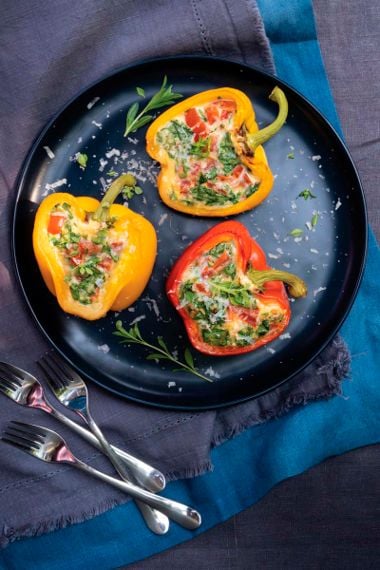Dinner in Reverse
Deep down, everybody loves breakfast—but few among us are lucid enough at daybreak to do anything more creative in the kitchen than float cereal in milk or slap a fried egg on toast.
The solution to getting more out of your cherished breakfast and brunch staples? Wake up your dinner routine by being slightly rebellious and transforming your typical morning foods into a perfectly executed meal tonight.
Yes, everything from pancakes to oats can take their turn on the dinner table. Far from a cop-out, serving breakfast stalwarts such as custardy scrambled eggs and berries for dinner can be your solution to quick, family-friendly meals while also keeping you on track for your healthy eating goals. Truth be told, many breakfast staples can supply the nutrients needed to power up immunity.
Here are five ways to break the rules and serve breakfast for dinner—and feel great about it.

Bake up omelettes inside bell peppers for a healthy, tasty, and quick end-of-day meal. If you’re cooking for a smaller crowd, this recipe is easily halved. Finish everything off with a scattering of chives and/or hot sauce. If steering clear of dairy, you can stir in nondairy milk and shredded vegan cheese.

We took classic cheesy nachos and gave them a breakfast vibe with scrambled eggs and then took them to the next level with satisfying add-ins including beans and creamy avocado. This is a perfect dinner to share around the table where a bit of mess is to be celebrated. You can also serve it with your favourite salsa.

Here, the breakfast favourite, granola, serves as a crunchy topping for this salad featuring seasonal delights, including sweet butternut and apple. The maple-date dressing is sure to be kid-approved. You can add cooked lentils to move it from side dish to complete plant-based meal. If desired, swap out butternut for pumpkin or sweet potato and add a creamy touch with feta or soft goat cheese.

If breakfast oatmeal is your jam, you’ll happily spoon up this oat-infused hearty chili. It comes together quickly enough to add to your weeknight dinner routine, but soaking the steel-cut oats ahead of time is key to having them cook more efficiently. Toppings run the gamut of avocado, sour cream, broken tortilla chips, cilantro, or grated cheddar.

These sweet-savoury pancakes are sure to bring smiles to anyone at the dinner table who longs for flapjack Sunday. If desired, you can add herby flavour to the pancakes with sage or rosemary instead of thyme and swap out parsnip for grated carrot. Serve with a side salad or a plate of roasted veggies.
Pay it forward
All sorts of breakfast favourites can also star at dinnertime. Here’s how to stretch your morning glories.
Granola
Scatter these crunchy oats on any salad or even over puréed soups.
Scrambled eggs
Stuff into tacos, grain bowls, enchiladas, and quesadillas.
Steel-cut oats
Use to bulk up chilies and soups; use as a whole-grain base for power bowls; or, instead of sweet stuff, stir savoury ingredients into a simmer pot with sliced sun-dried tomatoes, chopped greens, and herbs, and serve risotto-style.
Pancakes and waffles
Use as a whole-grain base for cooked proteins such as fish or grilled tempeh.
Nut butter
Whisk with oil, vinegar, and seasonings for a rich-tasting salad dressing, sauce for stir-fries, or an exciting topping for grilled meats.
Yogurt
Use thick styles as a creamy base for roasted vegetables, or whisk with curry, pesto, or harissa for use on tacos, lentils, or grain bowls.
Toast
A slice or two can serve as a foundation for everything from saucy beans to grilled chicken or a pile of chili.





